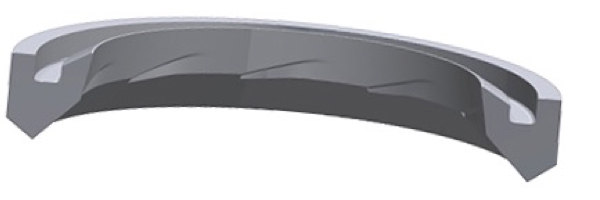Introduction
Most Kalsi-brand rotary seals are offered in a choice of materials with no single material being appropriate for all applications. Material selection often involves tradeoffs. Understanding the basic attributes of the materials we offer is the first step to selecting an appropriate seal material for your application.
Our seal materials are identified by a “dash number” that is combined with a basic part number to create a complete seal part number. For a complete list of the materials we offer, see our material options page.

HNBR Seal Materials
HNBR (Hydrogenated Nitrile-Butadiene Rubber) is the most common Kalsi Seal material for most applications because of its good combination of characteristics, such as abrasion resistance, compression set resistance, and chemical resistance. It is produced by the hydrogenation of NBR (Nitrile-Butadiene Rubber). Depending on formulation, the industry typically recommends an operating temperature range of −40 °F (−40 °C) to 320 °F (160 °C) for HNBR. HNBR has a good resistance to petrochemicals, acids, animal fats, water, and steam. Because of its improved temperature and chemical resistance performance compared to NBR, HNBR is widely used in the oilfield and automotive industries and has entirely displaced NBR as our workhorse seal material. Special precautions should be taken when using HNBR in brine-based drilling fluids containing zinc bromide or calcium bromide. To learn more about HNBR, see Chapter B2 of our shaft seal handbook.
Single material HNBR seals are typically made with our -11 (85-92 Shore A) or -10 (80 ± 5) seal materials. Compared to the -10 material, the -11 material has superior high-pressure extrusion resistance and abrasion resistance, but higher contact pressure and seal-generated heat. As a result, the -10 material is sometimes selected for applications with poor heat transfer.
Dual Durometer Kalsi Seals™ use a higher modulus seal material to define the dynamic lip, and a lower modulus seal material to load the dynamic lip against the mating surface of the shaft. This material combination provides increased high-pressure extrusion resistance and provides a significant torque reduction and cooler operation in some operating conditions. Dual Durometer Kalsi Seals have less abrasion resistance than single material HNBR Kalsi Seals.

FKM Seal Materials
FKM (Fluorocarbon Rubber) is often referred to by the Dupont trade name Viton and contains vinylidene fluoride. The grade or “type” of FKM has a significant impact on its chemical resistance and mechanical properties. FKM has better compression set resistance than HNBR at temperatures above 300 °F (165 °C). Industry sources quote the continuous operating temperature range of FKM as −15 °F (−26 °C) to 400 °F (204 °C). It is typically used as a seal material for lower differential pressure service when temperatures in the 300 to 400°F range are anticipated. FKM compounds do not resist abrasive wear as well as HNBR and are more costly. For additional information on our FKM seal materials, see Chapter B3 of our seal handbook.
Plastic Seal Materials
Several types of Kalsi Seals, including Plastic Lined Seals™, KLS® Seals, and BDRP Seals™, use a plastic layer to form part or all of the dynamic lip. In general, the plastic lining is used to provide improved high-pressure extrusion resistance or reduced breakout torque, compared to elastomer seal materials. Although the specific plastic compositions are trade secrets, the -33 liner material has the lowest breakout torque, and the -35 liner material has the best extrusion resistance and temperature capability. The -32 liner material has excellent extrusion resistance, and seals made with it are more flexible and easier to install than the -35 liner material. The -32 liner material is typically less expensive than the -35 liner material, but has less high temperature resistance. Plastic Lined Seals and BDRP Seals are constructed with an HNBR body to maintain compression between the mating shaft and the plastic liner. For additional information on our plastic liner materials, see Chapter C16 of our seal handbook.

Fabric reinforced Seal Material
Kalsi Engineering offers high performance washpipe packing that is molded from fabric-reinforced HNBR seal material. The fabric strengthens the elastomer for high pressure operation and reduces packing wear. Our material has a comparable operating temperature range and chemical resistance profile to other HNBR fabric reinforced seal materials found in the oilfield industry.

EPDM Seal Material
EPDM (Ethylene Propylene Diene Monomer Rubber) is offered as a seal material due to its resistance to hot water, steam, inorganic acids and bases, and phosphate ester based hydraulic fluids. It is known to have good abrasion and compression set resistance. It should not be used with petroleum-based fluids, fuels, greases, mineral oils, or diester lubricants. As quoted in industry sources, the operating temperature range of peroxide cured EPDM is typically −40 °F (−40 °C) to 300 °F (149 °C). See Chapter B5 of our seal handbook for additional information.
Contact Kalsi Engineering for additional information
Contact Kalsi Engineering for assistance in selecting the best seal material for your application. If you need assistance implementing Kalsi Seals in your rotating equipment, please complete and forward a copy of our application questionnaire, which is available in pdf and MS Word format.
